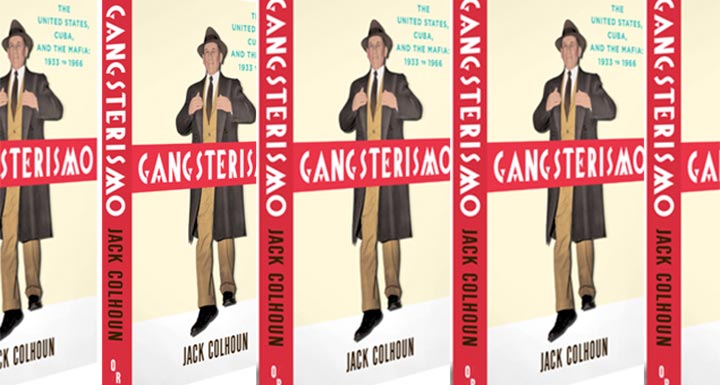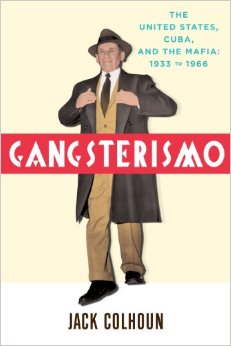
Gangsterismo: The U.S., Cuba and the Mafia
The Jack Calhoun book, “Gangsterismo,” is unique in the literature on Cuba, and establishes for the first time the integral, extensive role of mobsters in the Cuban exile movement. The narrative unfolds against a broader historical backdrop of which it was a part: the confrontation between the United States and the Cuban revolution, which turned Cuba into one of the most perilous battlegrounds of the Cold War. What follows is an excerpt of the book.
***
 The Kennedy administration moved to gain control over CIA-funded Cuban exile commando groups in the aftermath of the Cuban missile crisis, when the United States and the Soviet Union went to the brink of nuclear war in October 1962. The CIA cut off its generous subsidies to Cuban exile action groups that launched commando raids in Cuba from bases in Florida. (In 1963, the CIA would covertly arm and fund the “autonomous operations” of Manuel Artime and Manuel Ray.)
The Kennedy administration moved to gain control over CIA-funded Cuban exile commando groups in the aftermath of the Cuban missile crisis, when the United States and the Soviet Union went to the brink of nuclear war in October 1962. The CIA cut off its generous subsidies to Cuban exile action groups that launched commando raids in Cuba from bases in Florida. (In 1963, the CIA would covertly arm and fund the “autonomous operations” of Manuel Artime and Manuel Ray.)
Cuban exile leaders had not expected the Cuban missile crisis to end peacefully. They believed the United States would intervene militarily to remove the Soviet missiles and overthrow the Cuban revolution. When U.S. law enforcement agencies cracked down on unauthorized Cuban exile paramilitary operations and terminated its supply of aid and arms for exile action groups, Cuban exile leaders went into a funk.
The Mafia had been an integral part of the Cuban counterrevolution in exile since the triumph of the Cuban revolution. But, in 1963, Cuban exiles would increasingly turn to the Mafia as the gangsters filled the vacuum left by the CIA pullback.
Paulino Sierra Martinez made a big splash when he arrived in Miami in 1963. Sierra, backed by gangsters with gambling interests in Las Vegas, met with Cuban exile groups to promote his group Junta de Gobierno de Cuba en el Exilio (JGCE) (Junta of the Cuban Government in Exile). Sierra claimed his Mafia sponsors had $30 million for him to disperse to Cuban exile action groups.
The CIA took note of Sierra’s activities in Florida. “Sierra’s JGCE offered individual exiles and leaders of small groups a program under which Cubans would bring about the liberation of Cuba by their own efforts,” a CIA memorandum stated. “A movement that boasted ample financial backing without being tied to the apron string of U.S. policy must have seemed particularly appealing to exiles after the demise of the CRC, which had long been regarded as Washington controlled.”
Sierra’s backers were candid about their motives. In return for funding Cuban exile commandos, the gangsters expected support for the reestablishment of the Mafia’s gambling colony in post-Castro Cuba. According to a CIA report, “Sierra reportedly told Miguel León, a colleague of Manuel Artime Busea, that he represented U.S. gambling interests which were prepared to finance a united liberation movement.” The report added, “[I]n return Sierra’s backers would ask for gambling concessions once the Castro regime was overthrown.”
According to FBI Director J. Edgar Hoover, Attorney General Kennedy took “a personal interest” in Sierra’s activities in Miami. Sierra was unable to unify the Cuban exile movement around the JGCE. But he gained credibility after he provided funds for arms to Alpha 66, Comandos L, Movimiento Insurreccional de Recuperación Revolucionaria (MIRR) (Insurrectional Movement for the Recovery of the Revolution), a faction of the November 30th Movement, Second National Front of Escambray, and Unidad Revolucionario (UR) (Revolutionary Unity).
Sierra funded air operations in Cuba by Orlando Bosch’s MIRR in August and September 1963. A CIA cable reported that Sierra provided “the initial funds” for a MIRR air raid on the Cunagua sugar mill in Camaguey province on August 15. As we have seen, the CIA had an “operational interest” in Bosch in 1962. Bill Johnson, a North American pilot for Bosch, informed the FBI that Roberto “Chiri” Mendoza also helped finance MIRR’s bombing raid in Cunagua. Mendoza, a business associate of Batista and Santo Trafficante, was a former owner of the Havana Hilton casino. He was also linked to the Sans Souci nightclub and casino.
According to the FBI, MIRR flew a second mission over Camaguey on September 7, attacking the Jaronu sugar mill. An FBI report stated, “Four of these bombs exploded and . . . caused great damage to the sugar mill.” In September, the CIA learned that MIRR had obtained aircraft for future attacks in Cuba. “Two P-51 aircraft are being sold for the total sum of 16,000 dollars to Bill Johnson by Aero Enterprises, Inc. of LaPorte, Indiana,” stated a CIA cable. “Bill Johnson has napalm loaded drop tanks which he will attach in LaPorte.”
The Mafia took a special interest in blowing up oil refineries near Havana. On June 15, 1963, U.S. Customs agents broke up a plan to bomb the Shell Oil refinery, seizing a twin-engine Beechcraft airplane, explosives, and bombs at an abandoned airport near Miami. Michael McLaney, who bought the Hotel Nacional from Lansky’s allies in the Cleveland Syndicate in 1958, supplied the airplane and the money for the bombing mission. An FBI memorandum stated, “MM T-1 was of the opinion that McLaney was investing in the raid in order to earn some credit for future business operations in Cuba should the Castro regime be overthrown.” McLaney was a Mafia-linked businessman and sports gambler from New Orleans.
Mafia gambler Sam Benton organized the botched plan to bomb the Shell Oil refinery. Evelio Alpizar Pérez told the FBI, “Benton stated that he wanted the plane to carry two 300-pound napalm bombs and six 100- pound demolition bombs.” Benton, who worked for McLaney at the Hotel Nacional, tried unsuccessfully to recruit Alpizar for the Shell operation. McLaney described Benton’s role: “He lined up actions, arranged to fund and supply them, and took a percentage off the top.”
Benton had an unsavory reputation in Florida. An FBI report stated, “MM T-3 . . . advised that Sam Benton has been involved . . . with Cuban revolutionary groups in plans to sink yachts to obtain insurance, arms deals, and collection of funds for personal use.” On July 31, the FBI raided a farmhouse in Lacombe, Louisiana, near Lake Ponchartrain connected to another McLaney-sponsored plot to bomb targets in Cuba. The FBI seized 2,400 pounds of dynamite and twenty bomb casings. The farm belonged to McLaney’s brother William, a casino worker in Havana in the 1950s. Rich Lauchli, a Collinsville, Illinois, gun dealer, was tied to the explosives found in the farmhouse in Lacombe.
The Mafia used Lauchli, a cofounder of the ultra-right Minutemen, to supply arms and munitions to Cuban-exile commando groups. According to the FBI, Lauchli was introduced to “different Cuban exile leaders in Miami” by soldiers of fortune Frank Fiorini [Frank Sturgis] and Gerry Patrick Hemming. In return, Sierra provided funds for Hemming’s Interpen, which had a training camp for Cuban commandos outside of New Orleans.
Meanwhile, Santo Trafficante was well known among Cuban exile action groups as a one-stop source for weapons. A “Miami source” told the FBI, “Any anti-Castro group in the Miami area could obtain arms and ammunition from the ‘Mafia’ through Trafficante and that Trafficante would be willing to finance such purchases if he were given evidence groups [were] actually taking some action against Castro.” In February 1963, the CIA noted that Trafficante “reportedly gave aid for arms and ammunition to Serafín’s Movimiento Acción Patriótica for commando raids in Cuba.” Evelio Duque’s Ejército Cubano Anticommunista (ECA) (Cuban Anticommunist Army) met with an unnamed Trafficante representative to negotiate an arms deal a few months later. A source told the FBI, “Duque wanted to obtain rockets, high explosives, and detonators for use in raids against Cuba,” the source said. “Duque allegedly received $25,000 from Carlos Prío for this purpose.”
[Mafia arms dealer Dominick] Bartone and Duque’s emissary met . . . on June 25. FBI source MM T-1 reported that Bartone said he would make arrangements for the arms sale “with [Carlos] Prío and his brother Paco.” A CIA “Information File” on Duque described a July 1963 ECA military plan “to take the keys on northern coast of Las Villas province.” It added “The true purpose of the mission . . . was to embarrass the USA and force it into direct action against Cuba.” Duque may also have been receiving financial assistance from Batista for his operation in Las Villas. A July 13 CIA report stated, “Duque’s group appeared to have ample financial aid which was suspected of coming from Fulgencio Batista.”
Duque had a prior operational link to the Agency. A CIA trace file on Duque stated, “A POA [Provisional Operational Authorization] was granted Duque in Aug 61 . . .” The POA was canceled in May 1962. Meanwhile, Antonio Varona traveled to Chicago, where he met with Sam Giancana, Murray Humphreys, and other leaders of the Chicago Outfit in July 1963. A confidential CIA informant said that “four underworld figures made a contribution of $200,000 to him [Varona].”
Two months later the Directorio Revolucionario Estudiantil (DRE) (Revolutionary Student Directorate) also made a trek to Chicago. According to a CIA report, two DRE members gave Richard Cain, a Giancana lieutenant, a “purchasing list” of weapons. Cain told the CIA’s Domestic Contact office (OO/C) in Chicago that the DRE wanted two small speedboats, radar, 40-millimeter and 20-millimeter cannons, 50 caliber machine guns, 9-millimeter submachine guns, 45-caliber pistols, and bazookas. The DRE was willing to pay up to $25,000 for the weapons.
According to an unsigned CIA memorandum, Cain was instructed to “get out of the picture as soon as possible, and to make no commitment.
“Apparently the DRE is an MOB-controlled organization which, at times, seems to act independently of its monitor.” A handwritten note in the margin exclaimed “Amen!” The DRE also cultivated Bacardi Rum as a financial sugar daddy. An FBI report stated, “MM T-1, who is in regular contact Cuban exiles at Miami, Florida, active in revolutionary activities, advised that Luis Bacardi of the Bacardi Rum manufacturing family, has been financing some activities of the DRE.” JMWAVE, the Miami CIA Station, reported that the DRE was offering a $10 million reward for Castro’s assassination.
“Nov 63 issue See magazine . . . contains wanted poster of Fidel Castro on front cover,” JMWAVE reported. “Wanted poster is part of a story . . . gist of which is DRE offers 10 million dollars reward ‘to person or persons who with help of the DRE will assassinate Fidel Castro.’” JMWAVE Chief Theodore Shackley described the CIA’s relationship with the DRE to the FBI. A Bureau report stated, “His agency maintained an interest in the propaganda, political and intelligence activities of DRE, but did not sponsor and had no interest in the paramilitary operations of the DRE and was interested in preventing the DRE from executing any paramilitary operations.”
Mafia Fills the Vacuum: An Excerpt from Gangsterismo: The United States, Cuba, and the Mafia, 1933-1966 (OR Books) by Jack Colhoun.
Jack Colhoun is an independent historian of the Cold War, an investigative reporter and professional archival researcher. His work has appeared in the Washington Post, Toronto Star, The Nation, The Progressive, National Catholic Reporter, and Covert Action Quarterly. Colhoun was a longtime Washington bureau chief of the storied radical newsweekly The Guardian until it closed in 1992.


